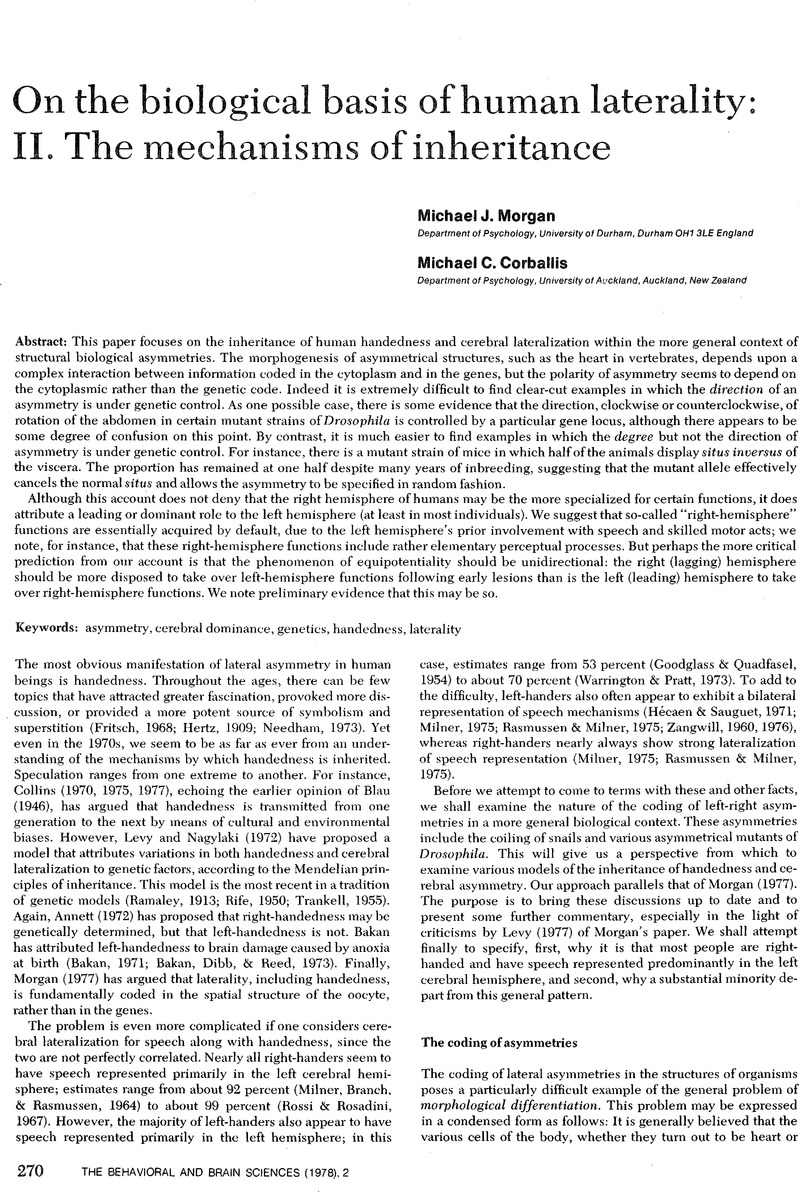No CrossRef data available.
Article contents
On testing the maturational left-right gradient hypothesis
Published online by Cambridge University Press: 04 February 2010
Abstract
An abstract is not available for this content so a preview has been provided. Please use the Get access link above for information on how to access this content.

- Type
- Open Peer Commentary
- Information
- Copyright
- Copyright © Cambridge University Press 1978
References
REFERENCES
Annett, M.Laterality of childhood hemiplegia and the growth of speech and intelligence. Cortex. 9:4–33. 1973.Google Scholar
Brown, J. W., and Jaffe, J.Hypothesis on cerebral dominance. Neuropsychologia. 13:107–10. 1975.Google Scholar
Buffery, A. W. H.Sex differences in the development of hand preference; cerebral dominance for speech and cognitive skill. Bulletin of the British Psychological Society. 23:233. 1970.Google Scholar
Ellis, H. D., and Young, A. W.Age of acquisition and recognition of nouns presented in the left and right visual fields: a failed hypothesis, Neuropsychologia. 15:825–28. 1977.Google Scholar
Hécaen, H.Acquired aphasia in children and the ontogenesis of hemispheric functional specialization. Brain and Language. 3:114–34. 1976.Google Scholar
McFie, J.The effects of hemispherectomy on intellectual functioning in case of infantile hemiplegia. Journal of Neurology, Neurosurgery, and Psychiatry. 24:240–249. 1961Google Scholar
Neville, H. The functional significance of cerebral specialization. In: Rieber, R. W. (ed.), Neuropsychology of language. New York: Plenum Press, 1976.Google Scholar
Piazza, D. M.Cerebral lateralisation in young children as measured by dichotic listening and finger tapping tests. Neuropsychologia. 15:417–25. 1977.CrossRefGoogle Scholar
Porter, R. J., and Berlin, C. I.On interpreting developmental changes in the dichotic right-ear advantage. Brain and Language. 2:186–200. 1975.Google Scholar
Richardson, J. T. E.Differential rates of cerebral maturation between sexes. Nature. 254:140. 1975.Google Scholar
Rudel, R., Teuber, H. L., and Twitchell, T. E.Levels of impairment of sensorimotor early damage. Neuropsychologia. 12:95–108. 1974.Google Scholar
Searleman, A.A review of right hemisphere linguistic capabilities. Psychological Bulletin. 84:503–28. 1977.Google Scholar
Selnes, O. A.The corpus callosum: some anatomical and functional considerations with special reference to language. Brain and Language. 1:111–39. 1974.Google Scholar
Smith, A. Dominant and non-dominant hemispherectomy. In: Kinsbourne, M. and Smith, W. L. (eds), Hemispheric disconnection and cerebral function. Springfield, Ill.: Charles C. Thomas, 1974.Google Scholar
Waber, D. P.Sex differences in mental abilities, hemispheric lateralisation and rate of physical growth in adolescence. Developmental Psychology. 13:29–38. 1977.Google Scholar
Wilson, P. J. E.Cerebral hemispherectomy for infantile hemiplegia: a report of 50 cases. Brain. 93:147–80. 1970.Google Scholar
Woods, B. T., and Teuber, H. L.Early onset of complementary specialization of cerebral hemispheres in man. Transactions of the American Neurological Association. 98:113–15. 1973.Google Scholar




